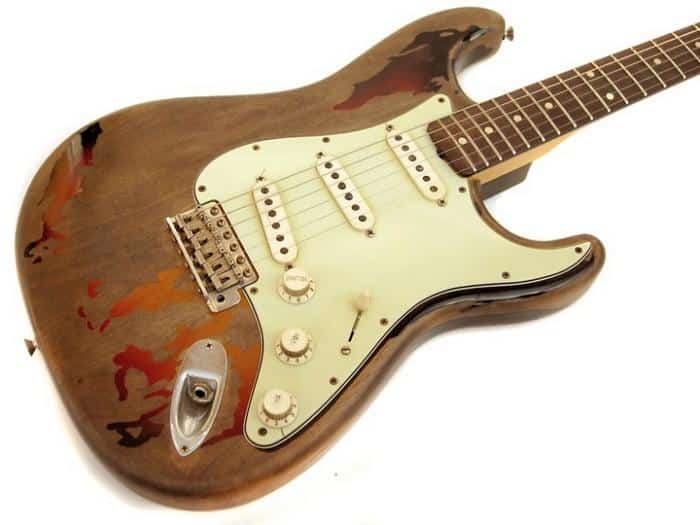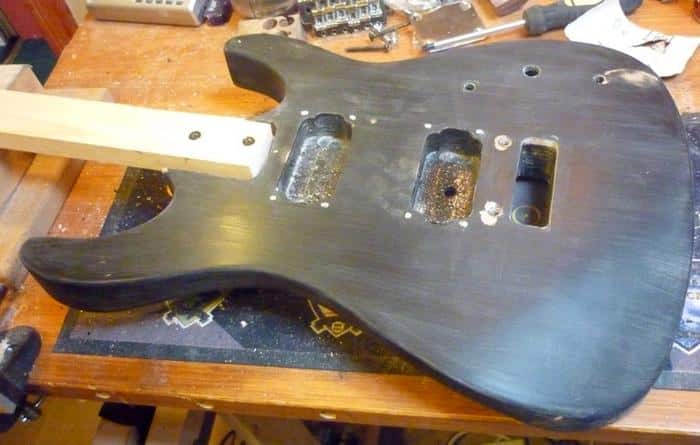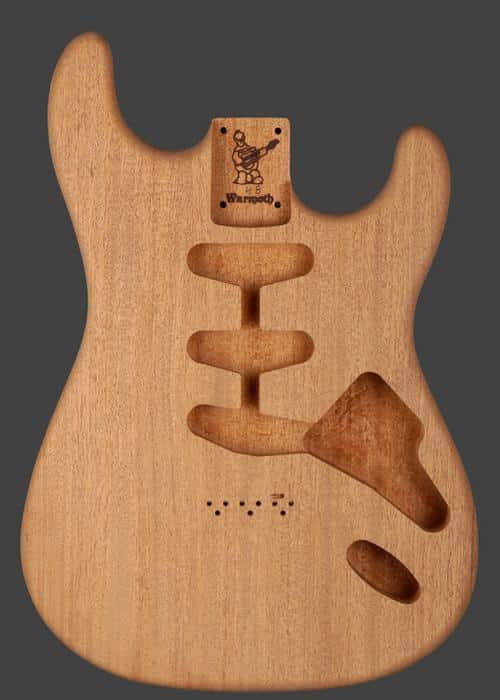Imagine, if you will, the rich, resonant sound of an 80-year-old guitar – one that’s been lovingly played and gently weathered by the passing of time. Now imagine obtaining that same sound, but from your brand new guitar, without needing to wait for decades. That’s not magic, it’s science! It’s the remarkable art of artificial aging, an incredible journey I’ve been privileged to be a part of, harnessing the power of UV light to speed-track the aging process.
My first encounter with this technique was a revelation. As an engineer-turned-luthier, I’ve always been intrigued by the intricacies of guitar design and aging. There was something about that seamless interplay between a guitar’s physical characteristics and its sound that kept drawing me back. Yet, nothing quite prepared me for this – the electrifying intersection of technology and tradition in the realm of guitar aging. Curious to find out how it ended? I can’t wait to share the rest with you.
Did you know, research has shown that the UV light, the same that ages our skin, could effectively speed up the aging process of a guitar? This gives it that well-seasoned sound much faster than Mother Nature ever could. I was as astounded as you probably are right now, and I know you’re itching to know more. Trust me, there’s plenty more fascinating details in store.
Guitars, both new and vintage, can substantially benefit from this process. Think of a brand new guitar gaining the mellowness and maturity of an aged guitar, or an old guitar’s faded finish being restored almost magically. It’s a controversial claim, I acknowledge, challenging traditional notions of the guitar aging process. Intrigued to discover how this could even be possible? Stick around, you might be pleasantly surprised!
Throughout the journey of aging a guitar using UV light, I’ve gathered a trove of expertise, data, and narrative elements. I’m eager to share my insights into topics like natural vs artificial aging, the impact of this process on different guitar components, and the art of refinishing the guitar after UV treatment, among others. With each paragraph, you will be diving deeper into the captivating world of UV-aged guitars, delving into technical details, potential outcomes, and answering FAQ’s you’re likely pondering.
This is your backstage pass into the science and art of artificial guitar aging. So strap in as we explore the fascinating world of artificially aged guitars using UV light. It’s going to be a thrilling ride!
Basics of Guitar Aging
Natural vs Artificial Aging

My journey into the world of guitar design and construction has instilled in me a profound understanding of how a guitar naturally ages over time and the intriguing ways we can mimic this process artificially. A particularly interesting facet of my research has been the impact of sunlight on guitar aging, and how we can harness this naturally occurring phenomenon using modern techniques.
Every aging guitar undergoes a transformation that gives it its unique tone and visual character. This natural process is gradual and often takes years, involving exposure to varying conditions, including environmental factors, playing styles, and handling nuances. A key player in this intricate process is sunlight, which progressively impacts the instrument’s look and sound as the sunlight’s properties slowly work their magic on the guitar’s components.
Being an aficionado of craftsmanship, I understand how time-honored these effects are. However, the beauty of our technological advancements today is that they offer a chance to speed up the journey, to see and hear these changes within reduced timescales. Here enters the concept of artificial aging. Just as it implies, artificial aging focuses on creating these naturally occurring transformations more abruptly, typically using controlled environments and specific tools.
A stunning application of such techniques is sunlight guitar aging, achieved artificially using UV light. This approach carefully simulates the long hours a guitar naturally spends in sunlight, greatly accelerating the weathering process, and resulting in aesthetic and auditory enhancements reflective of well-aged instruments.
Harnessing my experience in guitar making and my intensive studies in aging effects, I’ve detailed the process of artificially aging a guitar with sunlight. This amalgamation of crafting and science offers a quicker path to a vintage-looking and -sounding instrument, one which perhaps was not previously attainable because of the time required for the natural weathering process. As such, natural and artificial aging both importantly contribute to the intriguing world of aging guitars, though under different timelines and through different means.
Effect of Aging on Guitar Components

As I delved deeper into the world of luthiery, one aspect that particularly captivated my attention was the profound effect of aging on guitar components. This became more evident when I observed the aging effects on various wood types like spruce, maple, and alder, each responding to aging in its unique way.
The spruce top aging is particularly fascinating as it tends to darken the guitar top over time. This process is something more than just aesthetic; it contributes vastly to improving the overall resonance and sound quality. The transformation in the audio characteristics as the spruce top matures is truly remarkable.
When it comes to maple neck aging, the process typically enhances the guitar’s stability and playability. As the wood mellow ages, the resonance and the tone also tend to become more vibrant and richer.
Aging alder wood, on the other hand, presents a unique case. From my observations, aging alder wood gradually increases the instrument’s sustain and low-end frequencies, enriching it with a warm and resonant tone.
Another significant aging process involves the guitar’s lacquer or finish. As a luthier, watching the aging lacquer can be likened to witnessing a slow metamorphosis. This gradual change results in the nitrocellulose finish fading over time, giving the guitar a thriving vintage appeal while also enhancing its acoustic properties.
These experiences in my journey as a luthier have enriched my understanding of aging guitar components. They contribute significantly to creating an instrument that is not only visually appealing but also possesses superior tonal quality. The next pertinent query one could have is about the process of aging these components artificially, which I aim to discuss in the subsequent section. From my first-hand knowledge, I attest that UV light is an effective tool for creating that beautiful, aged look on a guitar while improving its sound profile.
Process of Aging Guitar with UV Light
Utilizing UV Light

In my quest for aging guitars, the selective manipulation of UV light emerged as a critical factor. This phase of the process began with finding the ideal UV lamp for guitar aging, a meticulous journey replete with enlightening discoveries and educational blunders.
UV light, primarily responsible for the nitrocellulose finish fade on guitars, became an essential tool in my arsenal. The use of UV light meant harnessing its potential to create an artificial yet authentic aging effect. However, it was imperative to control this powerful light source judiciously, as indiscriminate use could lead to an overdone, inauthentic look, or worse, damage the guitar.
Selecting the perfect UV lamp for guitars became a science of its own. It required careful consideration of essential factors such as the lamp’s size, power output, and wavelength. Every variation impacted the rate and nature of the fading guitar paint, resulting in a different aging effect.
The process of aging began by uniformly exposing the guitar’s surface to UV light. Prolonged exposure led to the discoloration we often see on vintage guitars, which was an essential step in achieving a faded, aged look. However, to make this aging effect seem believable, nuanced application was necessary. This meant regularly rotating the guitar to mimic natural UV exposure and using shades to protect spots that would usually be hidden from sunlight.
In addition to the nitrocellulose finish fade, I noticed a few other subtle changes as a result of UV exposure. The hardware started to tarnish, and the wood took on a distinct, deep hue. These changes corresponded perfectly with the rustic appeal we often associate with older guitars.
Although aging a guitar with UV light is a prolonged process, it offers a unique depth and character to the instrument that fast-tracked methods usually miss. It’s all about striking that perfect balance where the guitar looks aged, but not worn out. Remember, patience is key in this journey of painstaking precision and artistic intuition.
Rest assured, in the following section on refinishing the guitar, I’ll walk you through how to enrich and bolster your UV-aged guitar’s appearance effectively. Together, we will ensure that your beloved instrument not only sounds fantastic but also looks the part of a well-played, vintage guitar.
Refinishing the Guitar

Having established the significance of ultraviolet light in artificial guitar aging, the next crucial step is guitar refinishing. By melding my passion for both art and science, and leaning on my engineering background, I’ve developed a deep understanding of the complex technicalities involved in successfully refinishing a guitar. However, simple fascination isn’t enough; it’s the consistent quest for perfection that keeps me absorbed in the field.
Guitar refinishing, at its core, involves intricate processes. It’s not just about applying a shiny new coat to the timber. It’s about caressing the strings, exploring the guitar’s wear and tear patterns, and blending the old with the new. Each step is a testament to the love of craftsmanship, where the seasoned guitar meets the vibrancy of refurbishment. Therefore, understanding the impact of aging on key guitar components, a point we elaborated on earlier in the article, is critical.
A pivotal factor in this artistry is the aging lacquer. The play of ultraviolet light on lacquer isn’t only a scientific phenomenon, but it’s a spectacle – the new merging with, and transitioning into the old. The lacquer’s age, texture, and its interaction with UV light all contribute to the nuanced effects that are quintessential to this technique. Thus, in the balance of art and technicality, reminiscing my science background, the lacquer’s role cannot be overlooked. UV-induced transitions result in characteristic changes, creating a vintage aesthetic that not only enhances the guitar’s visual appeal but also its tonal quality.
In conclusion, refinishing, while it may seem simply superficial, is a multidimensional process that precisely works at the macro and micro-level of the guitar’s structure. It’s at the heart of artificial aging techniques, anchoring and bolstering all processes revolving around UV light utilization. As we look ahead at potential outcomes and effects in the next section, it’s crucial to remember the art, the science, and the sheer passion that underlie guitar refinishing.
Potential Outcomes and Effects

Observing the initial stages of a freshly applied finish to a guitar is a rewarding, yet patient process. Despite your eagerness to notice the development of the desired patina, the complex and dynamic aging of a guitar does take time. The gratifying journey sees the original bright and polished finishes transform, slowly, into a seasoned and cherished instrument, showcasing its unique signs of age with pride.
Watching and participating in this transformative process from the very beginning is akin to witnessing the birth and growth of a living entity. My experiences and knowledge on the subject have allowed me to appreciate each subtle change, knowing the aging process fortifies not just the visual appeal but also the tonal quality of the guitar.
What if I told you each transformation in a guitar’s aging process is a story that adds to its unique charm? The ambering of the clear coat, the darkening of the guitar top, and the fading of the guitar paint, are all chapters in a fascinating narrative.
Post-exposure to UV light, the amber color of a guitar is an awe-inspiring sight, a radiant glow as if lit from within. It becomes a visual testament to the harmonious blend of technology and tradition.
Talking about the guitar’s top, the UV light doesn’t bleach or damage it. Rather, it naturally darkens the guitar top, adding an appealing contrast, captivating one’s eyes with its antiqued charm.
As for the paint, expecting a painted guitar not to fade over time is unrealistic. fBut this gradual vanishing, the fading of the guitar paint, is just another delightful aspect of the aging narrative. A well-aged guitar carries this fading with grace, thereby accentuating the play of hues and tones across the body.
These changes may seem cosmetic at first glance, but they contribute significantly to the charisma of an aged guitar. The guitar’s patina, resulting from the synthetic aging process, lends it a sense of authenticity, making it stand out among a crowd of mass-produced instruments.
Naturally, the thought of artificially aging your beloved guitar may seem daunting. Yet as we have seen, intelligent use of UV light can induce these transformations safely and effectively. Over time, it imparts that characteristic aged look, enriching both the guitar’s visual appeal and tonal quality.
By the end of this chapter, I hope I’ve painted a realistic picture of the potential outcomes and effects that can be achieved when aging a guitar with UV light. Each step, each outcome reflects the magic of time and technology. And with each step, that simple piece of wood begins to echo the distinct charm of a beautifully aged guitar.
Remember, as you embark on this journey of transforming your guitar, treat the entire process as a story in the making. From the subtle changes in color to the emergence of a mesmerizing guitar patina, each transformation adds richness to its character, reflecting your personal touch in its enduring, musical legacy.
FAQs
What does “Artificial Aging a Guitar with UV Light” mean?
How does artificial aging using UV light work?
What impact does artificial aging with UV light have on the sound of the guitar?
Is it safe to artificially age a guitar with UV light at home?
Conclusion
So here we are at the end of our comprehensive guide on aging a guitar with UV light. Isn’t it fascinating that the personality of a guitar is shaped over years, but we can artificially recreate the same appeal in a fraction of time? Within this remarkable journey, we’ve navigated the basics of guitar aging, dissected the differences between natural and artificial aging, and thoroughly examined their effects on varied guitar components.
Our venture led us into the exclusive realm of aging guitars with UV light. We’ve explored the nitty-gritty of utilizing UV light effectively, meticulously covering the process from refinishing the guitar to its intriguing potential outcomes, effects, and common queries. Each fragment of this knowledge is invaluable for comprehending the art behind this skilled craft.
Throughout my time in lutherie, I’ve gathered that the real enchantment of guitar music stretches way beyond the melodies. The aging procedure, whether managed by time naturally or induced artificially with UV light, embeds its distinct personality into each guitar. This resonates deeply in every rhythm and strum, bringing forth the music’s soul.
Imparting this understanding and passion is the keystone that sparks my constant enthusiasm in this expertise. Sharing these insights with you, revealing the lesser-known aspects of guitars, and literally shedding light onto this captivating process of artificial aging have been incredibly gratifying.
Remember, aging a guitar is akin to honoring old wine – it takes skill, patience, and the magic touch of transformation. So, the next time you hold an aged guitar, remember the seasoned journey it signifies, and cherish the echoes of its unique personality strumming through time.
